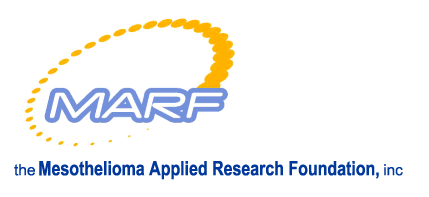|
Board of Directors
M. Ann Abbe
Arlington, Texas
Mathew Bergman, Esq.
Seattle, Washington
Robert B. Cameron, M.D.
UCLA Medical School
Michael Harbut, M.D., M.P.H.
Wayne State University
Ulf Jungnelius, M.D.
Pfizer, Inc.
Susan Vento
St. Paul, Minnesota
Nicholas J. Vogelzang, M.D.
Nevada Cancer Institute
Roger G. Worthington, Esq.
Dana Point, CA
In Memoriam
Congressman Bruce F. Vento
Science Advisory Board
Harvey Pass, M.D., Chairman
Karmanos Cancer Institute
Steven Albelda, M.D.
University of Pennsylvania
Raphael Bueno, M.D.
Harvard/Brigham and Women's
Steve Hahn, M.D.
University of Pennsylvania
Hedy Lee Kindler, M.D.
University of Chicago
Dan Miller, M.D.
Emory University
Lary A. Robinson, M.D.
H. Lee Moffit Cancer Center
Victor Roggli, M.D.
Duke University
W. Roy Smythe, M.D.
Texas A&M
Robert N. Taub, M.D.
Columbia University
Joseph R. Testa, Ph.D.
Fox Chase Cancer Center
Eric Vallieres, M.D.
Swedish Cancer Institute
Claire Verschraegen, M.D.
University of New Mexico
Executive Director
Christopher E. Hahn
Santa Barbara, CA
|

Our Mission is to eradicate mesothelioma as a life-ending disease.
May 10, 2005
VIA TELECOPY (202) 228-3954
and (415) 393-0710
The Honorable Dianne Feinstein
331 Hart Senate Office Building
Washington, D.C. 20510
Re: SB 852; Expanding List of 'Hot Spots' and Treating the Already Sick
Dear Senator Feinstein:
We commend you for your efforts in preventing premature asbestos-related
deaths by including a $40 million federal program in S. 852 that will
identify and remediate naturally occurring asbestos "hotspots"
in El Dorado, California. At the same time, we urge you not to forget
those Americans for whom prevention is too late. We estimate that today
more than 5,800 Americans with malignant mesothelioma are struggling to
survive from this aggressive, painful, costly and life-shortening cancer.
[1]
Although we've known about mesothelioma since at least the 1950s, the
federal government's current investment in research into treatments
for asbestos-cancer is virtually nonexistent. The National Cancer Institute
spent less than 1/10 of 1% of its budget on mesothelioma between 2000
and 2003. The lack of funding is particularly troubling for veterans of
the U.S. Navy who contracted mesothelioma by virtue of their service.
Neither the Department of Defense nor the Department of Veterans Affairs
have a medical research and treatment program for asbestos-afflicted veterans,
although quality medical programs are offered for prostate, ovarian and
breast cancer patients, among others.
We salute your leadership in focusing attention on the need for cancer
prevention. The program you have proposed recognizes that asbestos, in
whatever form, poses a serious health risk without regard to an exposed
person's age, job, title, sex, wealth or rank. The people in El Dorado
County deserve any protections that the government can provide.
However, there are literally hundreds of asbestos "hot spots"
throughout the country. Most of these surround former asbestos product
manufacturing plants. In California, for example, there are dozens of
neighborhoods surrounding former asbestos plants once operated by now
defunct asbestos companies such as Owens-Corning Fiberglass, Johns-Manville,
Zonolite/W.R. Grace and United States Gypsum. For decades W.R. Grace shipped
thousands of tons of asbestos-laced vermiculate to over 35 locations in
California. The children growing up around these plants face at least
the same risks as the children in El Dorado County.
Asbestos fibers are toxic whether they come from the ground or from a joint
compound, a disc brake or a fireproofed school ceiling. We would urge
you to expand your program to inventory all hot spots throughout the nation,
whether the source is "naturally occurring" or from an abandoned
mine, factory, steel mill, refinery or vermiculite expansion plant. Priority
should be given to those counties which already have unacceptably high
mortality from mesothelioma, such as Los Angeles County, Cook County,
Illinois, Philadelphia County, Pennsylvania, King County, Washington,
and Somerset, New Jersey. Three of the top 12 counties with the highest
asbestos-related mortality are in California.
The Mesothelioma Applied Research Foundation (MARF) has been working closely
with Senator Herb Kohl (D-WI) who shares our concerns for the patient
community and believes investing in biomedical research now will pave
the way for effective treatments and cures.
MARF is a consortium of patients, doctors, trial lawyers and manufacturers
who believe that a cure is within reach if we commit the resources. Since
2000, MARF has funded more research grants aimed at treating mesothelioma
than the U.S. Government and industry combined. We have proposed a comprehensive
mesothelioma research and treatment program which finally begins to address
the long overdue and exigent needs of present and future mesothelioma patients.
Sincerely,
Christopher E. Hahn
Executive Director
cc: Jennifer Duck
Office of Senator Dianne Feinstein
Enclosure
[1] We estimate that at present in the U.S. at least 5,800 patients are
suffering with mesothelioma (pleural, peritoneal, pericardial and testicular)
with the caveat that the actual population may be substantially greater.
Several factors confound our estimate, including 1) the lack of mesothelioma
registry or clinical database in the U.S. (unlike many European countries),
2) many patients who believe treatments are hopeless remain within their
community without referral to experts, and 3) the degree of difficulty
in rendering a proper diagnosis raise the risk of misdiagnosis. Mesothelioma
is often simply and wrongly lumped in with "lung cancer."